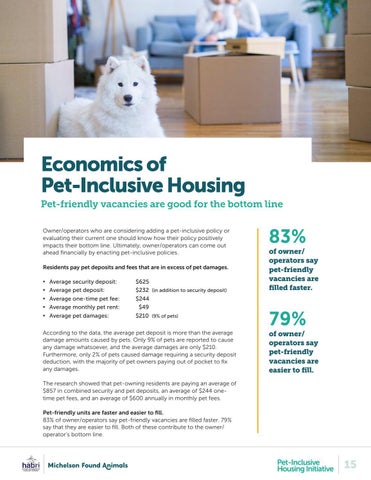Economics of Pet-Inclusive Housing Pet-friendly vacancies are good for the bottom line Owner/operators who are considering adding a pet-inclusive policy or evaluating their current one should know how their policy positively impacts their bottom line. Ultimately, owner/operators can come out ahead financially by enacting pet-inclusive policies. Residents pay pet deposits and fees that are in excess of pet damages.
▪ ▪ ▪ ▪ ▪
Average security deposit: Average pet deposit: Average one-time pet fee: Average monthly pet rent: Average pet damages:
$625 $232 (in addition to security deposit) $244 $49 $210 (9% of pets)
According to the data, the average pet deposit is more than the average damage amounts caused by pets. Only 9% of pets are reported to cause any damage whatsoever, and the average damages are only $210. Furthermore, only 2% of pets caused damage requiring a security deposit deduction, with the majority of pet owners paying out of pocket to fix any damages.
83% of owner/ operators say pet-friendly vacancies are filled faster.
79% of owner/ operators say pet-friendly vacancies are easier to fill.
The research showed that pet-owning residents are paying an average of $857 in combined security and pet deposits, an average of $244 onetime pet fees, and an average of $600 annually in monthly pet fees. Pet-friendly units are faster and easier to fill. 83% of owner/operators say pet-friendly vacancies are filled faster. 79% say that they are easier to fill. Both of these contribute to the owner/ operator’s bottom line.
Pet-Inclusive I Iousing Initiative
15




